Porifera Study guides, Class notes & Summaries
Looking for the best study guides, study notes and summaries about Porifera? On this page you'll find 201 study documents about Porifera.
Page 4 out of 201 results
Sort by
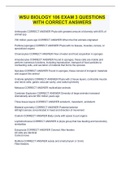
-
WSU BIOLOGY 106 EXAM 3 QUESTIONS WITH CORRECT ANSWERS
- Exam (elaborations) • 15 pages • 2023
-
- $9.99
- + learn more
Arthropods CORRECT ANSWER Phyla with greatest amount of diversity with 85% of animal spp 700 million years ago CORRECT ANSWER When the first animals originated Porifera (sponges) CORRECT ANSWER Phyla with no tissues, muscles, nerves, or specialized organs Choanocytes CORRECT ANSWER Flow of water and food acquisition in sponges Amoebocytes CORRECT ANSWER Found in sponges, these cells are mobile and perform numerous functions, including reproduction, transport of food particles to nonf...
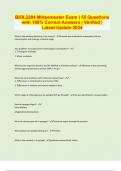
-
BIOL2204 Midsemester Exam | 55 Questions with 100% Correct Answers | Verified | Latest Update 2024
- Exam (elaborations) • 7 pages • 2023
-
- $10.49
- + learn more
What is the working definition of an animal? - Animals are multicellular eukaryotes that are heterotrophic and undergo a blastula stage Two problems associated with morphological classification? - 1. Convergent evolution 2. Minor mutations Why was the organism found in the 90s labelled as a bivalve mollusc? - Because it was consuming bivalve eggs and had traces of their DNA in its gut. What are some problems with molecular sequencing? - 1. Differences in mitochondrial and nuclear DNA ...
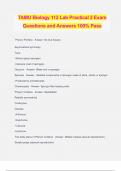
-
TAMU Biology 112 Lab Practical 2 Exam Questions and Answers 100% Pass
- Exam (elaborations) • 23 pages • 2024
- Available in package deal
-
- $12.49
- + learn more
TAMU Biology 112 Lab Practical 2 Exam Questions and Answers 100% Pass Phylum Porifera - Answer- No true tissues Asymmetrical symmetry Taxa: -Silicea (glass sponges) -Calcarea (rest of sponges) Osculum - Answer- Water exit in sponges Spicules - Answer- -Skeletal components of sponges made of silica, calcite or spongin -Produced by amoebocytes Choanocytes - Answer- Spong's filter-feeding cells Phylum Cnidaria - Answer- Diploblastic Radially symmetrical Cnidocytes Classes: -Anthozoa...
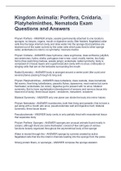
-
Kingdom Animalia: Porifera, Cnidaria, Platyhelminthes, Nematoda Exam Questions and Answers
- Exam (elaborations) • 3 pages • 2022
-
- $9.99
- + learn more
Phylum Porifera - ANSWER simple, sessile (permanently attached to one location) sponges; no tissues, organs, mouth or digestive cavity; filter feeders: flagellated collar cells line the large internal cavity and draw water into the sponge (food particles are strained out of the water current by the collar cells which pass food to other sponge cells); acolemate (no colon); no symmetry; most are marine Phylum Cnidaria - ANSWER class hydrozoa, class scyphozoa, class anthozoa; jellyfish, sea anem...
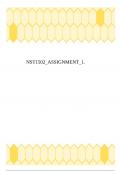
-
NST1502_ASSIGNMENT_1.
- Exam (elaborations) • 10 pages • 2023
-
- $2.60
- + learn more
NST1502_ASSIGNMENT_1. Detailed working, solutions, memo, notes & explanations. CONTENTS Introduction ............................................................................................................................................................ 2 Question 1 .............................................................................................................................................................. 2 1.1.1. Scientific method ...........................................
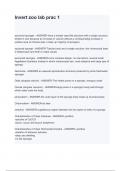
-
Invert zoo lab prac 1 questions and answers
- Exam (elaborations) • 6 pages • 2024
-
- $7.99
- + learn more
asconoid sponges - ANSWER-have a simple vase-like structure with a single osculum, limited in size because an increase in volume without a corresponding increase in surface area of choanocytes ( make up majority of sponges) syconoid sponge - ANSWER-Tubular body and a single osculum, the choanocyte layer is folded back and forth to make canals leuconoid sponges - ANSWER-more complex design, no real atrium, several small flagellated chambers instead in which choanocytes are, most adaptive an...
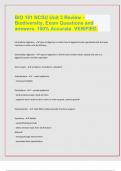
-
BIO 181 NCSU Unit 3 Review – Biodiversity, Exam Questions and answers. 100% Accurate. VERIFIED.
- Exam (elaborations) • 7 pages • 2023
-
Available in package deal
-
- $7.99
- + learn more
BIO 181 NCSU Unit 3 Review – Biodiversity, Exam Questions and answers. 100% Accurate. VERIFIED. Intracellular digestion - -type of digestion in which food is digested inside specialized cells that pass nutrients to other cells by diffusion Extracellular digestion - -type of digestion in which food is broken down outside the cells in a digestive system and then absorbed Germ Layers - -ectoderm, mesoderm, endoderm Endoskeleton - -- under epidermis - increased mobility Exoskeleton - ...
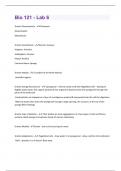
-
Bio 121 - Lab 6 exam (100% correct and graded A+)
- Exam (elaborations) • 6 pages • 2023
- Available in package deal
-
- $3.49
- + learn more
Grantia Characteristics - Eukaryotic Heterotrophic Multicellular Grantia Classification - Domain: Eukarya Kingdom: Animalia Subkingdom: Parazoa Phylum Porifera Common Name: Sponge Grantia Habitat - -Coastline of the North Atlantic -Intertidal regions Grantia Energy/Food Source - -Spongocoel - internal cavity lined with flagellated cells - beating of flagella draws water, fine organic particles & tiny organisms (bacteria) into the spongocoel through tiny pores of the body wall -Food ...
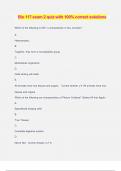
-
Bio 117 exam 2 quiz with 100% correct solutions
- Exam (elaborations) • 49 pages • 2024
-
- $13.49
- + learn more
Bio 117 exam 2 quiz with 100% correct solutions Which of the following is NOT a characteristic of ALL animals? A. Heterotrophic B. Together, they form a monophyletic group. C. Multicellular organisms D. Cells lacking cell walls. E. All animals have true tissues and organs. - Correct Answer ️️ -All animals have true tissues and organs. Which of the following are characteristics of Phylum Cnidaria? (Select All that Apply) A. Specialized stinging cells B. True Tissues C. Comp...
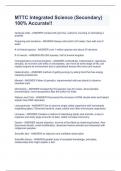
-
MTTC Integrated Science (Secondary) 100% Accurate!!
- Exam (elaborations) • 15 pages • 2024
-
Available in package deal
-
- $11.99
- + learn more
Graticule slide - ANSWER marked with grid line, useful for counting or estimating a quantity Preparing acid solutions - ANSWER Always add acid to 2/3 water, then add rest of water # of Animal species - ANSWER over 1 million species and about 30 divisions # of insects - ANSWER 800,000 species, half of animal kingdom Characteristics of animal kingdom - ANSWER muliticellular, heterotrophic, reproduce sexually, do not have cell walls or chloroplasts, can move at some stage of life, can r...

Study stress? For sellers on Stuvia, these are actually golden times. KA-CHING! Earn from your study resources too and start uploading now. Discover all about earning on Stuvia


